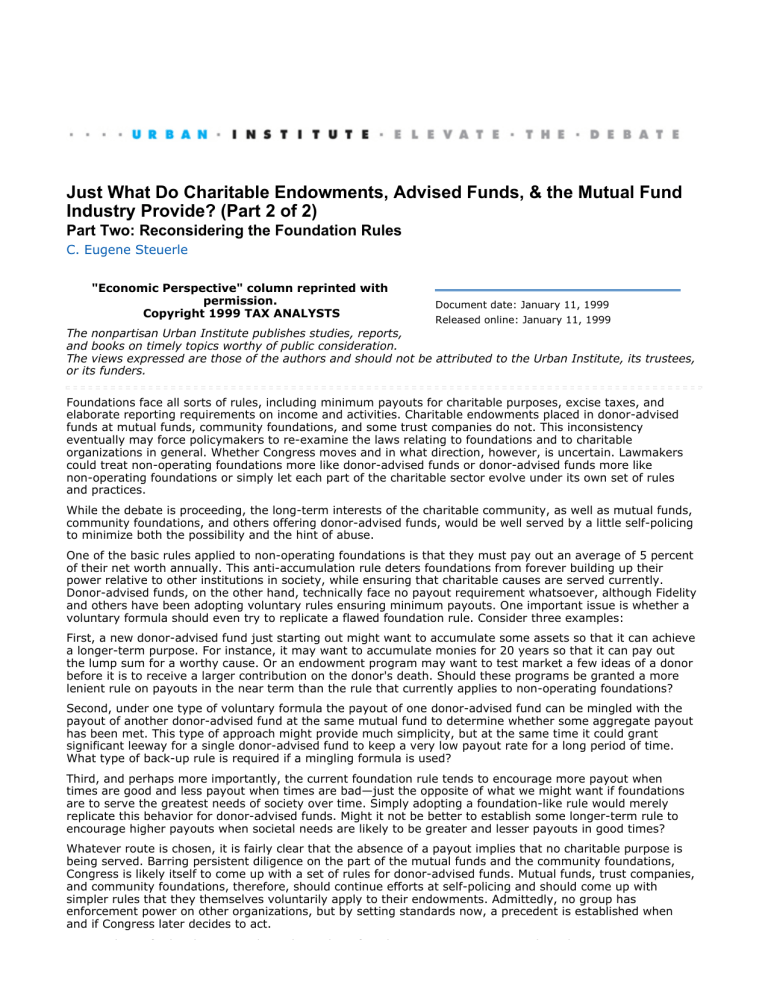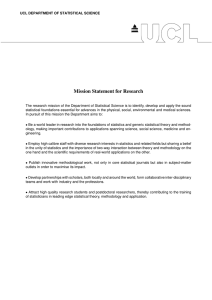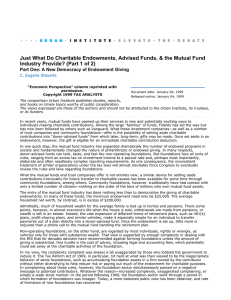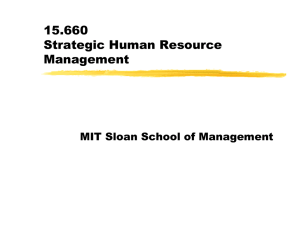Just What Do Charitable Endowments, Advised Funds, & the Mutual... Industry Provide? (Part 2 of 2)

Just What Do Charitable Endowments, Advised Funds, & the Mutual Fund
Industry Provide? (Part 2 of 2)
Part Two: Reconsidering the Foundation Rules
C. Eugene Steuerle
"Economic Perspective" column reprinted with permission.
Copyright 1999 TAX ANALYSTS
Document date: January 11, 1999
Released online: January 11, 1999
The nonpartisan Urban Institute publishes studies, reports, and books on timely topics worthy of public consideration.
The views expressed are those of the authors and should not be attributed to the Urban Institute, its trustees, or its funders.
Foundations face all sorts of rules, including minimum payouts for charitable purposes, excise taxes, and elaborate reporting requirements on income and activities. Charitable endowments placed in donor-advised funds at mutual funds, community foundations, and some trust companies do not. This inconsistency eventually may force policymakers to re-examine the laws relating to foundations and to charitable organizations in general. Whether Congress moves and in what direction, however, is uncertain. Lawmakers could treat non-operating foundations more like donor-advised funds or donor-advised funds more like non-operating foundations or simply let each part of the charitable sector evolve under its own set of rules and practices.
While the debate is proceeding, the long-term interests of the charitable community, as well as mutual funds, community foundations, and others offering donor-advised funds, would be well served by a little self-policing to minimize both the possibility and the hint of abuse.
One of the basic rules applied to non-operating foundations is that they must pay out an average of 5 percent of their net worth annually. This anti-accumulation rule deters foundations from forever building up their power relative to other institutions in society, while ensuring that charitable causes are served currently.
Donor-advised funds, on the other hand, technically face no payout requirement whatsoever, although Fidelity and others have been adopting voluntary rules ensuring minimum payouts. One important issue is whether a voluntary formula should even try to replicate a flawed foundation rule. Consider three examples:
First, a new donor-advised fund just starting out might want to accumulate some assets so that it can achieve a longer-term purpose. For instance, it may want to accumulate monies for 20 years so that it can pay out the lump sum for a worthy cause. Or an endowment program may want to test market a few ideas of a donor before it is to receive a larger contribution on the donor's death. Should these programs be granted a more lenient rule on payouts in the near term than the rule that currently applies to non-operating foundations?
Second, under one type of voluntary formula the payout of one donor-advised fund can be mingled with the payout of another donor-advised fund at the same mutual fund to determine whether some aggregate payout has been met. This type of approach might provide much simplicity, but at the same time it could grant significant leeway for a single donor-advised fund to keep a very low payout rate for a long period of time.
What type of back-up rule is required if a mingling formula is used?
Third, and perhaps more importantly, the current foundation rule tends to encourage more payout when times are good and less payout when times are bad—just the opposite of what we might want if foundations are to serve the greatest needs of society over time. Simply adopting a foundation-like rule would merely replicate this behavior for donor-advised funds. Might it not be better to establish some longer-term rule to encourage higher payouts when societal needs are likely to be greater and lesser payouts in good times?
Whatever route is chosen, it is fairly clear that the absence of a payout implies that no charitable purpose is being served. Barring persistent diligence on the part of the mutual funds and the community foundations,
Congress is likely itself to come up with a set of rules for donor-advised funds. Mutual funds, trust companies, and community foundations, therefore, should continue efforts at self-policing and should come up with simpler rules that they themselves voluntarily apply to their endowments. Admittedly, no group has enforcement power on other organizations, but by setting standards now, a precedent is established when and if Congress later decides to act.
A second set of rules that currently applies only to foundations is even more complex. The excise tax on
A second set of rules that currently applies only to foundations is even more complex. The excise tax on investment income of foundations was put into the law with the stated intent, at least in some congressional documents, of financing the IRS's monitoring of the charitable sector. The money collected, however, has always been well in excess of the cost of all IRS efforts with regard to the exempt organization sector as a whole—even more in excess of the cost of policing the foundation subsector. Moreover, this money was never dedicated to the administrative function of the IRS's Employee Plans/Exempt Organizations operation but was instead transferred to general revenues. The recent IRS restructuring formally delinks this source of funding from the EP/EO function.
In many ways, this excise tax violates most standards of efficiency and equity and can only be understood as a penalty developed historically against the past abuses, real or perceived, of foundations. IRS officials, however, have given foundations high marks recently and have indicated that private foundations are less likely to be an area of the charitable sector requiring enforcement resources.
While the excise tax is not huge, it is a nuisance, especially for smaller foundations. It violates standards of simplicity in taxation, which call for limits on the number of taxes imposed by the state. Its particular design creates all sorts of havoc with filing and other requirements. As only one example, Martin Sullivan and I demonstrated a few years ago that the current payout rule actually discourages paying out larger percentages of endowment in any year because one consequence is a higher—yes, a higher—tax in future years. That is, the formula penalizes a foundation if it does not pay out a percentage of assets currently in excess of what it paid out in the recent past. Pay out more now, and the foundation is more likely to pay a penalty in the future if that higher payout rate is not maintained.
Since the tax is hard to justify, there is not much of a case to be made (other than a legal bent for consistency) for extending it from non-operating foundations to the new forms of donor-advised funds. Note again that the types of charitable endowments that most mutual funds and community foundations support often involve little more than making contributions and paying out grants. If Congress is not willing to get rid of this tax but wants to provide consistent treatment, it might extend the benefits of nontaxation to those foundations that look no different from many of the simpler donor- advised funds. In effect, I am suggesting that any distinction here be made less on the basis of form of organization and more on types of activities of the organization.
A third area of difference sometimes cited involves the varying expenditure policies of donor-advised funds.
For example, in some mutual fund operations there may be little investigation of the worthiness of a recipient organization. A list of charitable organizations from the IRS may be all that is cross-checked by a mutual fund, while the donor-advisors typically have no paid staff to advise them. In community foundations, on the other hand, there more likely are to be limits on how much control resides with the donor-advisor, while potential donees are often culled by community foundations to include only organizations in the region that are considered worthy of support. (For further detail on variations in practice, see comments by Victoria
Bjorkland; edited transcript of the July 31, 1998, ABA Exempt Organization Committee meeting: Doc
98-30340 (53 pages) or 98 TNT 198-45.) Differences here are in practice more than in law—a mutual fund could engage in significant checking, a non-operating foundation may check almost nothing, or vice-versa.
Because of the inconsistency both within and across foundation and donor-advisor subsectors, it is especially difficult to think of a reform that might apply only to one or the other. It's also almost impossible to think of any rule that works. Certainly, requiring higher administrative expenses would not ensure better quality of grant-making.
A final source of distinction is that the elaborate filing requirements for foundations tend to be avoided by most donor-advised funds. Because of the ways these funds are set up, there usually can be no possibility of a disputed activity (such as self-dealing or excess business holdings); hence no extra filing requirement on the donor-adviser makes sense. That should serve as an incentive for Congress and the IRS to figure out when foundations might also meet a standard for simpler filing requirements, and to the foundation sector to seek intermediaries that could simplify their lives as the mutual funds are now doing for donor-advised funds.
On the other hand, some filing requirements—such as lists of grants and contributions paid or approved—probably should be made more uniform across the board. But those requirements should be made in a way that still holds the reporting burden on mutual funds and community foundations to a reasonable minimum.
Mutual funds have helped democratize endowment giving through donor-advised funds, laying open some exciting prospects for the future of philanthropy. Their expansion has also laid bare some of the differences in tax law treatment both between and among foundations and donor-advised funds, ranging from payout rates to excise taxes to expenditure policies to complexity of filing requirements. The positive development of donor-advised funds should be pushed off course neither by a drive toward consistent application of needlessly complex rules, as now apply to many non-operating foundations, nor by a laissez-faire attitude that would encourage abuse or the perception of abuse. This narrow path is one that the Congress, the Treasury, the IRS, non-operating foundations, community foundations, and the mutual fund industry must figure out how to walk together.
| Part One: A New Democracy of Endowment Giving |
Other Publications by the Authors
C. Eugene Steuerle
Usage and reprints: Most publications may be downloaded free of charge from the web site and may be used and copies made for research, academic, policy or other non-commercial purposes. Proper attribution is required. Posting UI research papers on other websites is permitted subject to prior approval from the Urban Institute—contact publicaffairs@urban.org
.
If you are unable to access or print the PDF document please contact us or call the Publications Office at (202) 261-5687.
Disclaimer: The nonpartisan Urban Institute publishes studies, reports, and books on timely topics worthy of public consideration. The views expressed are those of the authors and should not be attributed to the Urban Institute, its trustees, or its funders. Copyright of the written materials contained within the Urban Institute website is owned or controlled by the Urban Institute.
Source: The Urban Institute, © 2012 | http://www.urban.org



